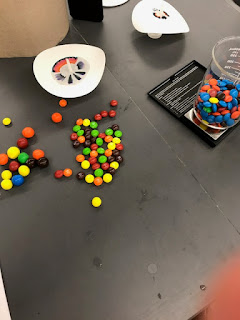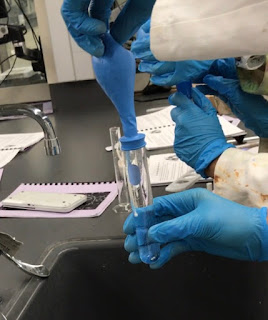Lab 4: Atomic Mass of Candium Lab
Atomic Mass of Candium Lab
Introduction:
The purpose of this lab was to use a new element called Candium and calculate its average atomic mass. We were given several different quantities "Candium" atoms which represented different isotopes, and a scale. The important terms for this lab was isotope, percent abundance, and average atomic mass. An isotope is the different variations of the same atom just with different number of neutrons or different atomic masses. Percent abundance is the amount of an isotope that is present in the world in comparison to other isotopes, so basically how common the isotope is found. Average atomic mass is the sum of each type of isotope multiplied by its decimal abundance all divided by 100.
Data:
Our average atomic mass of Candium was 0.955 grams
(0.71842)x(0.8376g) + (0.22407)x(0.985g) + (0.05809)x(2.29g) = 0.995g
↑ ↑ ↑
(Decimal abundance of each isotope corresponding to its atomic mass)
Questions:
1. Ask a group nearby what their average atomic mass. Why would your average atomic mass be different than theirs?
Another group's average atomic mass was 1.10g. Our atomic mass would be different than another groups because each group may have a different percent abundance and/or slightly different atomic masses for each isotope. This would change the average atomic mass because then when they calculate their average atomic mass they will have slightly different numbers when multiplying changing the result compared to yours.
2. If larger samples of candium were used, for example if I gave you a whole backpack filled with candium, would the differences between your average atomic mass and others' average atomic masses be bigger or smaller? Defend your answer.
If you had a larger amount of Candium, the differences between our average atomic masses would be smaller because if you have a larger quantity, the average will be more accurate. That means that if everyone's average was more accurate, then they should all be closer to the actual average and the closer they are to each other, the less the difference.
3. If you took any piece of Candium from your sample and placed it on the balance, would it have the exact average atomic mass that you calculated? Why or why not?
If we took any piece of Candium from our sample and placed it on the balance, it would highly unlikely be the exact average because the average is from a collection of different atoms that each have there own atomic mass. It is possible but extremely rare because each Candium atom is slightly different but relatively close to the average.
Conclusion:
In conclusion, this lab was an overall success because we were able to complete the purpose of finding the average atomic mass. We encountered no problems with any of the procedures so it was fairly simple to find all of the data and do the calculations.





Comments
Post a Comment